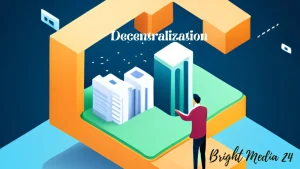Exploring Future Directions in Blockchain Technology
In the realm of technological innovation, few concepts have captured the imagination and potential for radical transformation quite like blockchain technology. What began as the foundational framework for cryptocurrencies has now emerged as a multifaceted and dynamic force poised to reshape industries, redefine trust, and drive unparalleled advancements. As we stand at this juncture, peering into the horizon of possibilities, it becomes imperative to delve into the uncharted territories that lie ahead. This exploration embarks on a journey to unveil the future directions and key considerations that will shape the trajectory of blockchain technology. Beyond its origins, blockchain’s evolution encompasses diverse applications, challenges to be overcome, and the promise of a decentralized future. Join us on this expedition as we navigate the landscapes of innovation, uncover the intricate tapestry of blockchain’s potential, and decipher the roadmaps that will guide its transformative journey.
Introduction:
Blockchain, once synonymous with cryptocurrencies, has matured into a paradigm-shifting technology that promises to revolutionize industries and redefine established norms. Beyond its initial association with digital currencies, blockchain’s potential to reshape systems, enhance transparency, and foster trust is a frontier worth exploring. This article embarks on a comprehensive journey to delve into the future directions and critical considerations that will shape the evolution of blockchain technology.
The Evolution of Blockchain:
Blockchain technology, which originated with the advent of cryptocurrencies, has undergone a profound and multifaceted evolution that extends far beyond its initial purpose. Initially introduced as a secure and transparent ledger system for digital currencies like Bitcoin, blockchain’s potential quickly transcended its cryptocurrency roots. Over time, it has evolved into a versatile technology that redefines concepts of trust, transparency, and decentralization, revolutionizing various industries and shaping the way we interact with digital systems.
The genesis of blockchain technology can be traced back to the publication of the Bitcoin whitepaper by Satoshi Nakamoto in 2008. This seminal document laid the groundwork for a decentralized, tamper-proof ledger that recorded transactions in an immutable and transparent manner. Bitcoin itself represented the first practical application of blockchain, offering an alternative to traditional financial intermediaries by facilitating peer-to-peer electronic transactions.
The trajectory of blockchain’s evolution unfolded as it ventured beyond its cryptocurrency origins. Developers’ exploration of its broader potential was ignited by the concept of decentralization, distributing control among participants. This catalyzed the emergence of diverse cryptocurrencies and the creation of blockchain platforms enabling smart contract execution—automated agreements with preset conditions. Ethereum’s introduction in 2015 marked a milestone, extending blockchain’s functionality through smart contracts that automated processes across industries like supply chain management, healthcare, and decentralized finance (DeFi).
Blockchain’s maturation unveiled its adaptability to address real-world challenges. Initiatives emerged to tackle issues ranging from provenance and identity verification to intellectual property. Both startups and established enterprises recognized blockchain’s attributes—transparency, security, and efficiency—as transformative forces capable of reshaping traditional business models. This expansion led to the rise of interoperability solutions like Polkadot and Cosmos, facilitating seamless communication among diverse blockchains. Scalability enhancements, such as sharding and layer 2 protocols, further enhanced blockchain networks’ capacity to handle substantial transaction volumes.
Amidst its growth, concerns arose about blockchain’s environmental impact, particularly in energy-intensive proof-of-work (PoW) consensus mechanisms. These concerns drove the exploration of more eco-friendly alternatives like proof-of-stake (PoS), which reduced energy consumption while maintaining security. Blockchain’s fusion with emerging technologies, notably AI, heightened data integrity and transparency. Its tamper-resistant nature also fortified the security of IoT devices, safeguarding data integrity within this interconnected landscape.
Blockchain’s journey triggered regulatory considerations as governments and institutions navigated its implications. While some embraced its potential, others grappled with defining effective regulatory frameworks. Significantly, blockchain’s mainstream acceptance materialized as financial institutions, tech giants, and governments explored its applications. Continuing to evolve, blockchain remains characterized by ongoing innovation, technological strides, and evolving societal demands. The persistent pursuit of solutions for scalability, interoperability, privacy, and sustainability underscores its relevance. The horizon ahead envisions blockchain’s escalating prominence, playing an instrumental role in shaping industries, governance structures, and the very fabric of our digitally interconnected world.
Emerging Trends and Their Influence on Blockchain:
The blockchain landscape is marked by dynamic trends that are driving its evolution. Interoperability, a critical concern in the fragmented blockchain ecosystem, is gaining prominence as projects aim to seamlessly communicate across different blockchain networks. This trend promises to enhance collaboration, scalability, and the overall utility of blockchain technology. Furthermore, the evolution of consensus mechanisms, such as proof-of-stake (PoS), introduces energy-efficient alternatives to traditional proof-of-work (PoW), contributing to sustainability and scalability.
Pioneering Innovation (Balancing Scalability, Privacy, and Security):
One of the paramount challenges facing blockchain technology is striking the delicate balance between scalability, privacy, and security. Sharding, a technique that divides the blockchain into smaller segments, holds promise in addressing scalability concerns, enabling networks to process an increasing number of transactions without compromising decentralization. Concurrently, privacy-focused technologies, such as zero-knowledge proofs and confidential transactions, are being developed to protect sensitive data while preserving the transparency inherent to blockchain.
Governance and Regulation in a Decentralized Landscape:
The maturation of blockchain technology invites critical discussions surrounding governance and regulation. As blockchain transcends borders and industries, differing regulatory approaches across jurisdictions pose challenges and opportunities. Striking the right balance between regulatory oversight and fostering innovation is paramount, as governments grapple with defining legal frameworks that accommodate technological advancements while addressing concerns related to security, fraud, and taxation.
The Socioeconomic Paradigm Shift:
Blockchain technology’s impact extends far beyond the realm of technology. It introduces a new socioeconomic paradigm, reshaping traditional power dynamics and empowering individuals. Blockchain’s potential to enhance financial inclusion by providing access to banking services for the unbanked and underbanked populations is a notable achievement. Moreover, its role in supply chain transparency, reducing fraud, and ensuring ethical sourcing signifies a departure from conventional business practices.
Convergence of Technologies:
Blockchain’s integration with other emerging technologies like artificial intelligence (AI) and the Internet of Things (IoT) heralds an era of interconnected, secure, and transparent digital ecosystems. IoT devices can securely interact and share data through blockchain’s decentralized architecture, while AI algorithms can leverage blockchain’s tamper-proof nature to enhance accountability and transparency in decision-making processes.
Decentralization's Complex Reality
Decentralization, the cornerstone of blockchain technology, introduces complex considerations. Achieving true decentralization while ensuring scalability and efficiency is an intricate challenge. The role of miners, validators, consensus mechanisms, and governance structures all play pivotal roles in determining the level of decentralization in a blockchain network. Striking the right balance between trust, control, and efficiency remains an ongoing pursuit.
Sustainability and Environmental Responsibility:
Blockchain’s rapid growth has raised concerns about its environmental impact, particularly in the case of energy-intensive PoW consensus mechanisms. As the technology advances, efforts to promote sustainability through energy-efficient PoS mechanisms and innovative consensus algorithms gain traction. The blockchain community’s commitment to minimizing its carbon footprint is essential to ensuring a responsible and sustainable digital future.
Turning Vision into Reality:
Transitioning from conceptual promise to tangible impact presents a set of challenges and opportunities. Technical barriers, interoperability issues, scalability bottlenecks, and public acceptance hurdles all contribute to the complex landscape of blockchain implementation. Collaboration between governments, enterprises, academia, and the blockchain community is imperative to surmount these challenges and unlock the technology’s full potential.
Conclusion
In conclusion, the journey of blockchain’s evolution from its origins in cryptocurrencies to a versatile and transformative technology reflects a remarkable trajectory of innovation and progress. Its impact extends beyond digital currencies, encompassing a wide range of industries and use cases. Blockchain’s potential to reshape systems, enhance transparency, and empower individuals underscores its significance as a foundational pillar of the digital age.
As we navigate the uncharted waters of blockchain’s future, we encounter a realm of untapped possibilities and unexplored territories. The trajectory of blockchain technology is shaped by emerging trends, regulatory landscapes, socioeconomic implications, and technological innovations. Embracing this future requires a holistic approach that balances innovation with ethics, decentralization with practicality, and sustainability with progress. As blockchain continues to mature, its influence will extend far beyond technology, impacting the way we conduct business, govern societies, and interact with the digital world. The journey ahead promises both challenges and rewards, inviting stakeholders to collectively pioneer a transformative era powered by blockchain technology.






